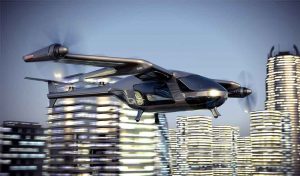For many years now, if someone asked us to picture the future, flying cars were one of the first things to come to mind. But Urban Air Mobility (UAM) is much more than “flying cars”. UAM is the challenge of safely and securely integrating drones, of ever-increasing size, into the airspace in and around our cities.
UAM will enable a wide range of services which will increase mobility of people and cargo in a wide variety of contexts such as ambulances, taxis and parcel delivery. UAM will improve our health and well-being by delivering medical supplies or by transporting packages more time-efficiently.
All those who live in big cities and need to commute every day are tired of wasting their time in traffic jams. During the pandemic, many people are working or taking classes from home leading to less congestion and a significant reduction of vehicle noise. People who live near congested roads, airports or even in metropolis have experienced a new peacefulness from the lack of cars or aeroplanes. In addition, carbon emissions have sharply fallen. All this leads to one question- what we, as an industry, have learnt to help face the environmental challenge during the recovery? An innovative mindset is required to ensure a sustainable recovery.
 The aviation industry has been facing the environmental challenge for a long time now. All the new services we introduce need to help reduce the environmental impact of flying. The UAM concept is based around sustainable vehicles: electric vertical take-off and landing (eVTOL) aircraft which would have a positive contribution for the environment.
The aviation industry has been facing the environmental challenge for a long time now. All the new services we introduce need to help reduce the environmental impact of flying. The UAM concept is based around sustainable vehicles: electric vertical take-off and landing (eVTOL) aircraft which would have a positive contribution for the environment.
Moving some traffic from the roads to the skies will help reduce traffic congestion; but what happens with the noise generated by drones? And will we be able to afford them? Have you heard how loud and expensive those little things are?
Well, eVTOL aircraft use electric power hence the noise and emissions compared with current generation of fossil fuel helicopters are significantly lower. The initial outlay may be expensive, but as with other technological advances, costs will fall quickly if the environmental benefits lead to a large number of neighbourhoods adopting this type of service – a low carbon addition to urban transit for passengers and/or cargo. Who knows, it may be that the first few will be subsidised by local governments wishing to avoid traffic congestion and the high costs of land-based alternatives such as light rail and metro systems.
eVTOL are coming soon – but there are still some challenges to overcome, with the main one being battery life, but the enabling technologies that make these initiatives a reality are developing fast and are supported by significant public funds nationally and in the EU. However, it is not all about technology. Regulators and infrastructure perform a very important part when it comes to integrating UAM into our daily lives.
Integration into our society
A drone is not as heavy as an aircraft, but a drone collision over populated areas will put lives at risk. Given that the vast majority of drones will fly at “very low level” or VLL [1], the obstacles that a drone needs to avoid scale from wildlife or gliders in a rural or semi-rural environment to buildings, lights and even aircraft if the city is near enough to an airport. This is one of the reasons why technologies like detect and avoid [2] are essential to enable unmanned aircraft the full autonomy that would really lead to full integration.
So, when we consider integration we need to consider the risk to life and property and how it can be mitigated – for example by restricting where we allow drones to operate or the type of weather they are allowed to be flown in. As we progress and more mitigations become available then we should be able to relax the restrictions. But a need to update our regulations will become necessary.
We are making progress however with smaller drones (from the EASA “open” and “specific” categories). In the UK for example, to fly a drone between 250g and 20kg you need to register and pass a test. As drones get bigger, then additional mitigations might be needed to reduce the risk. But drones capable of carrying cargo or people are subject to the full set of aviation regulations – and frankly they are just not scalable to enable multiple air taxis to operate in above a city – that is going to require real automation.
Let’s be clear – UAM is not about “flying cars”. We can still call them “flying cars” but it is not the rule set for cars that apply – we can’t all just jump in an eVTOL and hope we don’t get lost. Drones need access to airspace. They need to keep a safe distance from each other and any other aircraft in the vicinity. We would need to ensure that a “flying traffic jam” does not occur within the UAM concept. Collision avoidance technologies and tactical planning systems will allow drones to change their route when an unexpected hazard appears. We need a system that warns the drone with enough time to react and recalculate its route and avoid the other vehicle and get safely to the destination (or an alternate) before the battery runs flat. The research in this area is getting there – the UK Governments “Future Flight Challenge” is looking at the heady mix of regulatory change and infrastructure to make this a reality.
We can’t get there in one step; we need to find short-term solutions that get the industry moving towards the “Jetsons” lifestyle to which we all aspire? So, whilst drones cannot be compared to cars we can use analogy of current traffic rules to investigate the sort of UAM rules we might need. For example, what happens when we hear an ambulance approaching? We drive to the side of the road to let it pass through. Something similar could be adopted for UAM – where an air ambulance requires it, an area of reserved airspace moving with the ambulance drone would warn all drones that the area is restricted. This is called as dynamic geo-fence [3] area and would make safe the flight to or from the hospital.
Drones need somewhere to park too.
The eVTOLs that you want to use to get to the office, don’t need an airport – they don’t take-off and land as aircraft do – but they do need somewhere to land and recharge the batteries. In cities and urban areas we are going to need vertiports [4] and they are a really essential piece of the UAM puzzle. The idea behind vertiports is that they can be at the top of the (properly strengthened) buildings in useful locations – for example at the top of the short-stay car park at your favourite airport.
Big Challenges but Big Rewards
Future flight, be it manned or unmanned, is a big challenge for the aviation industry. Drones have already shown its capabilities helping not only mankind but animals too. Australia utilised them to reach unburnt small areas with the objective of finding wildlife and assist them. Besides, smart initiatives have taken place in a wide range of environments; from forests to cities and from populated to hard-to-reach areas with the idea of making our future world a better place to live in. If we want to continue to benefit from these new cleaner forms of aviation then we also need to tackle the regulatory and infrastructure challenges that come with the higher intensity of the operations being considered.
We in the aviation industry believe in innovation to improve quality of life. That is why we are constantly working to bring challenging concepts like UAM to reality.

Author: Irene Bravo, ATM Consultant
Additional Information
[1] Very Low Level (VLL) embrace the airspace area commonly used by VFR flights – Below 500ft.
[2] Detect and avoid (DAA). The capability to see, sense, or detect conflicting traffic or other hazards and take appropriate action. Source: REMOTELY PILOTED AIRCRAFT SYSTEM (RPAS) CONCEPT OF OPERATIONS FOR INTERNATIONAL IFR OPERATIONS. ICAO.
[3] In UA (Unmanned Aviation), geo-fence refers to the geographic description of the boundaries that should not be crossed by a drone.
[4] Vertiports are the airports where electric vertical take-off and landing (eVTOL) aircraft undertake these manoeuvres.


Recent Comments